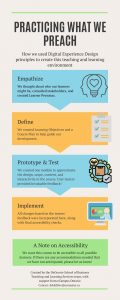Introduction
Welcome! We are excited to be on this learning journey with you.
Full video with transcript [opens in new tab]
Overview
Throughout the four modules and 16 chapters that make up this course, we will explore how Digital Experience Design can be applied to teaching and learning environments to maximize the impact of online or blended courses. This course takes the form of an open-access online guidebook, containing instructional videos, detailed information, templates, links, interactive exercises, and much more. These resources will be comprehensive for those who wish to complete the entire course, while also providing varied, searchable examples and information for those who are looking for “just-in-time” support.
Check out the section at the bottom for a full Table of Contents, including clickable links to each chapter!
Our Process
—Click for a downloadable Microsoft Word document of this Intro Process Infographic.
A Note on Navigation and Accessibility
This course is built in Pressbooks, an open-access educational platform supported by eCampus Ontario. To navigate throughout this course, you should familiarize yourself with these features:
—Click in the BOTTOM-RIGHT corner of the window above to view in fullscreen.
We have made every effort to ensure this course is accessible to all possible learners. This includes making use of:
- closed captions on all videos
- alternative text on images, graphics, and other media
- high contrast colours and fonts
- accessible formatting for headings, tables, and other HTML features
- Learning Objectives at the top of each page
- Takeaways and Resources at the bottom of each page
If you have any accessibility needs that we have not included, please reach out to DeGroote’s Teaching and Learning Services team at dsbEdDev@mcmaster.ca and we would be happy to accommodate these requirements to the best of our ability.
The Course at a Glance
Module 1: Defining Online Education for You and Your Learners
Chapter 1: Exploring Terminology for the Online Learning Environment
- Shared vocabulary for online learning
- What is constructive alignment? Why should you care?
- How can this be applied to a course?
Chapter 2: Defining Success and the Learner’s Experience
- Discovery Questions
- Universal Design for Learning
- Your Turn: What are the goals for your learning experience?
Chapter 3: Structuring Content for Online Learning
- Strategies for structuring your content
- Communicating the structure to your learners
- How might we put this into practice?
Chapter 4: Translating Existing Resources for Online Delivery
- Lectures and other teaching methods
- Assessments
- Engagement
- Bringing it all together
Module 2: Conceptualizing Digital Experience Design for Impactful Teaching
Chapter 5: The Digital Experience Design Process – From Ideation to Implementation
- 6 Steps of the Design Thinking Process
- How you can connect Design Thinking to Digital/Learning Experience Design
- Using MURALcommunity boards for working on your learning experiences
- Why Learner Personas matter
- Empathy Mapping
- Designer’s Corner: A look behind the scenes
- The importance of Storytelling
- Intentional Design and Learning Journey Mapping
- Learning Experience Blocks and Artifacts: Revisited
- Frictionless Digital Experience Design
- User Experience vs. Learning Experience Design
- Selecting Digital Tools
Module 3: Implementing Strategic Tools and Techniques for Learning
Chapter 9: Various Audiences – Teaching Strategies and Methods
- Meeting the needs of a diverse audience of learners
- Teaching at a distance – methods that work
- Deciding the best experience for learners
- Transforming your learners’ experience
- Tools and their purpose
- Including quality assets
- Mapping the connections
- Tools for collaboration and interaction
- Organizing content for usability
- Tips for presenting online
- Designing for accessibility
- 7 core skills for digital accessibility
- 10 principles for adding accessibility to your websites
- Tips for designing for colour blind learners
- Design tools and testing tools for accessibility
Module 4: Creating Long-Lasting Digital Learning Assets
Chapter 13: Creating Long-Lasting, Asynchronous Learning Assets
- Tips and tricks for creating long-lasting content
- Applying these tips for both document and video creation
Chapter 14: Creating Instructional Videos: Technology Recommendations from Low- to High- Tech
- Different types of technology
- How you can use technology to enhance your videos
- Platforms to record and edit your video
Chapter 15: The Production Process for Creating Instructional Videos
- Pre-production: script writing, storyboarding, and rehearsing your content
- Production: best practices for recording videos
- Keeping accessibility in mind
Chapter 16: The Final Steps: Post-Production and Delivering Accessible Content
- Post-production: editing your video
- Uploading and Exporting your video
- Closed Captions and Transcripts – why they are important


